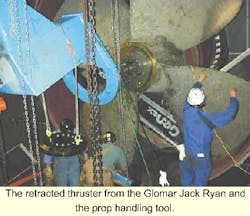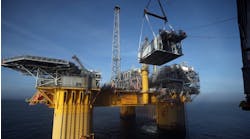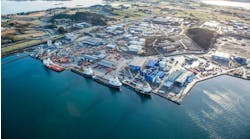DRILLING RIG TECHNOLOGY: Rig thruster design allows on-site changeout, prop seal replacement
The retracted thruster from the Glomar Jack Ryan and the prop handling tool.
There is a delicate balance between operational uptime and system reliability. The longer a system runs without interruption, the more likely it is to fail. To increase the percentage of time a mobile offshore drilling unit can continue working, while not affecting its reliability, designers are looking at ways to perform regular maintenance, inspection, and repairs without interrupting drilling activities.
This was a major driver in some of the design choices made by Global Marine on its new generation of drillships. This investment apparently has paid off with the first successful repair of a retractable azimuthing thruster on the Glomar Jack Ryan offshore Trinidad. The repair, which called for the propeller shaft seals to be replaced, was made while the vessel remained dynamically positioned and without interruption to the drilling operations underway.
When Global Marine designed its fifth-generation drillship, the Glomar Jack Ryan, Scott Brittin, then a Global Marine Senior Project Engineer, said the company put a lot of thought into design features that would allow the vessel to stay in operation and on station as much as possible. One system that traditionally requires a vessel to be pulled off location for maintenance is the thruster.
Azimuthing thrusters
Fifth generation drillships routinely operate in water depths considered too deep for conventional mooring systems. To stay on station above the well, a drillship uses multiple thrusters linked via computer to a global positioning system and subsea acoustic beacons.
To dynamically position the vessel, the thrusters, positioned in different areas of the hull, work against weather and currents to hold a constant position. If this system were to fail, it would require an emergency disconnect at the seabed.
The Glomar Jack Ryan has three thrusters located near the bow and three near the stern. These are azimuthing thrusters that can rotate 360 degrees and power up at different thrust levels to keep the vessel on station. To do the job effectively, the thruster propeller is located several meters below the hull. When a drilling unit goes into port or in shallow water, it is necessary to either retract or remove these thrusters so they will not run aground.
Such a system is not unusual for a fifth-generation drillship, but the designers of the Glomar Jack Ryan took the concept a step further. Rather than just retracting the thruster canisters to accommodate shallower water, the thrusters on the Glomar Jack Ryan are capable of retracting completely into the hull of the vessel, with the propeller completely clear of the water.
Maintenance
Periodically, a drillship has to return to port and be dry-docked for inspection and maintenance. In addition, if there is ever a problem with a thruster, such as a failure in the shaft seal, this normally would require divers and a potentially dangerous, time-consuming keel-haul procedure (where the thruster is dropped out of the hull and pulled to the surface alongside the hull).
With the fully retractable canister thrusters, Brittin said, maintenance such as cleaning, painting, and repair can be performed in a dry, safe environment. In addition, inspections can be carried out in the same way. The plan is to retract each of the thrusters periodically for inspection and maintenance, avoiding costly trips inshore. However, when a shaft seal began to fail offshore Trinidad, the crew looked at the practicality of performing a repair while keeping the vessel on station without interrupting drilling operations.
While the vessel is on station, the six thrusters typically all run at the same time at relatively low power to keep the vessel in position. The goal is to keep sufficient load on the engines and the thrusters warmed up, so oil is circulating in the event additional thrust from one or more of the thrusters is required in a hurry to help maintain position.
Although all six thrusters are normally running, with the vessel's DPS-3 classification, three thrusters are sufficient to hold the vessel on station. This is part of the basic DPS-3 design, since it allows for redundancy and could accommodate the failure of one or more thrusters without losing stationkeeping ability. Fred Brooks, Global Marine Operations Manager for the Glomar Jack Ryan, said he used the drillship's DP simulation software to demonstrate that the vessel could easily hold position under the currents and weather it was experiencing with four, or even three, thrusters in operation. This demonstration shows that the thruster needing repair could be brought off-line while maintaining station and also having a redundant thruster in the event of failure.
Retracting procedure
The canister thrusters are designed to retract without the need for a crane. Each is mounted on a rack and pinion drive system similar to that on a jackup rig. There are four hydraulic motors on each canister, and the canisters run on two racks, one on either side. The canisters are fed power and utilities, cooling water, and everything they need to operate through two umbilicals, which move with them when they are retracted. The only part that requires disconnection is a 14-in. duct that provides ventilation, Brittin said.
To retract a thruster, it is first necessary to shut it down. Then the propeller drive assembly is rotated into the retraction position. The ventilation duct is disconnected, and a button is pressed to begin the retraction process. If the thrusters are only being retracted for shallow water, they are raised about 5 meters. Getting up to maintenance level, where the entire propeller is clear of the water, requires the removal of a hatch above the thruster to provide clearance for the upper portion of the canister. The total retraction height for this procedure is roughly 14 meters. Brittin said the entire elevation process, once the hatch is set aside, can be accomplished in less than an hour.
Repairs
In the case of the Trinidad operation, the prop had to be removed to change the seals, so one of the vessel's cranes was used to lower the prop-handling tools. There is an area below decks called the maintenance space that is just large enough for the prop-handling tools and the maintenance crew.
Once the equipment is in place, the prop is removed from the retracted thruster using a portable hydraulic pump, an air hoist, and rigging. The prop-handling tool is bolted up to the prop to hold it secure and then rolled out of the way while the seals are changed. Start to finish, the entire process can take as little as 24 hours without interrupting any of the vessel's regular activities.
The process not only avoids costly downtime, but with the aid of sensors, could make the scheduling of future repairs more flexible.




